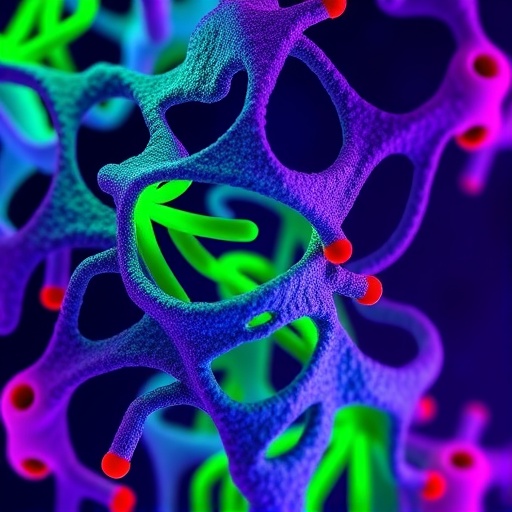In the intricate world of cellular biology, proteins perform a myriad of essential functions, but their journey to the correct cellular compartment is a meticulously regulated process. One of the pivotal challenges within plant cells is the insertion of tail-anchored proteins into the endoplasmic reticulum (ER) membrane, a step critical for their function. This maneuver is executed through the Guided Entry of Tail-Anchored proteins (GET) pathway, yet the molecular underpinnings governing the regulation of GET receptors have eluded scientists—until groundbreaking research by a team led by Dr. Lei Zhang sheds new light on this mystery.
Proteins characterized by a “tail anchor” do not follow the classical co-translational targeting pathway of most membrane proteins. Instead, they rely on post-translational insertion into the ER membrane, which requires a highly coordinated system to ensure cellular fidelity and efficiency. In plants, the GET pathway is responsible for this crucial task, orchestrating the recruitment and proper insertion of such tail-anchored proteins into the ER membrane. The central players in this pathway are two receptors, AtGET1 and AtGET2, which must be precisely regulated to form a functional complex.
The newly published study reveals that the lipid composition of the ER membrane, specifically the presence of the phospholipid phosphatidylinositol-4-phosphate (PI4P), serves as a central regulatory element. Contrary to its usual scarcity in the ER, PI4P transiently accumulates to act as a molecular magnet that draws AtGET1 and AtGET2 into close proximity. This early clustering is indispensable for the subsequent formation of a stable receptor dimer, a prerequisite for the effective insertion of tail-anchored proteins.
This discovery challenges the previously held view that protein-protein interactions alone dictate GET receptor assembly. Instead, it positions the lipid PI4P as a dynamic organizer within the membrane, modulating receptor dimerization. The researchers describe PI4P’s role as a transient recruiter, initiating the close association of AtGET1 and AtGET2 but not stabilizing the complex indefinitely. This transient nature is critical because it allows for precise temporal control over receptor complex formation.
The stabilization of the AtGET1 and AtGET2 receptor complex is mediated by the ER-localized enzyme RHD4, which functions as a phosphatase. RHD4 enzymatically removes a phosphate group from PI4P, converting it to phosphatidylinositol (PI). This dephosphorylation event effectively locks the receptor pair into a stable conformation, enabling the proper insertion of tail-anchored proteins into the membrane. This biochemical switch signifies a novel regulatory mechanism that links lipid metabolism directly to protein trafficking, a connection previously underappreciated in plant cell biology.
Dr. Lei Zhang emphasizes that this phosphoinositide-phosphatase module constitutes a previously unrecognized paradigm in the orchestration of membrane protein trafficking. By leveraging transient lipid signals, cells gain exquisite control over the spatiotemporal assembly of receptor complexes. This mechanism not only underlies ER membrane organization but also can influence diverse cellular processes dependent on membrane composition and protein localization.
From a functional standpoint, this regulatory switch is essential for root hair development, a process heavily reliant on targeted insertion of tail-anchored proteins to maintain membrane dynamics and signaling pathways. The inability to form stable GET receptor complexes compromises the protein insertion process, which directly impacts root hair growth and, by extension, nutrient uptake and environmental response in plants.
Beyond the immediate context of Arabidopsis, these findings resonate broadly within cell biology. The concept of lipid-mediated switching regulating protein complex formation introduces a new layer of membrane biology. It suggests that cells might universally employ phosphoinositide signaling to modulate a variety of trafficking pathways, potentially extending to other eukaryotic systems including yeast and mammals.
The study employed sophisticated experimental techniques, combining live-cell imaging, biochemical assays, and genetic perturbations to delineate the roles of PI4P and RHD4. This multidisciplinary approach allowed the researchers to decode the dynamic interactions within the ER membrane and connect lipid modifications to functional outcomes in protein trafficking.
Crucially, the identification of PI4P’s role challenges traditional models that viewed membrane lipids as passive components. Instead, lipids emerge actively as signaling entities orchestrating complex molecular events. This opens avenues for future research to explore other lipid species that might regulate different protein complexes through analogous mechanisms.
The broader implications of this work also touch on agricultural biotechnology. By understanding the molecular basis of tail-anchored protein insertion and its regulation via membrane lipids, new strategies can be devised to manipulate root hair growth and improve plant resilience. Enhanced nutrient uptake through optimized root hair development could translate to major gains in crop productivity under environmentally challenging conditions.
In conclusion, this pioneering research illuminates a sophisticated, lipid-centric regulatory switch governing the dimerization of GET pathway receptors in Arabidopsis. The dynamic interplay between phosphoinositides and phosphatases sets a new framework for understanding membrane organization and protein trafficking, with ramifications that extend well beyond plant biology. As cells harness the transient power of lipids to orchestrate protein complexes, we gain insights into fundamental biological principles with far-reaching significance.
Subject of Research: Not applicable
Article Title: A Phosphoinositide-Mediated Switch of GET Pathway Receptor Dimerization in Arabidopsis
Web References:
10.1073/pnas.2514354122
Image Credits: Credit: © RUB, Marquard
Keywords: Tail-anchored proteins, ER membrane, GET pathway, phosphatidylinositol-4-phosphate (PI4P), AtGET1, AtGET2, RHD4 phosphatase, protein trafficking, Arabidopsis, membrane lipid regulation, root hair growth, phosphoinositide signaling




